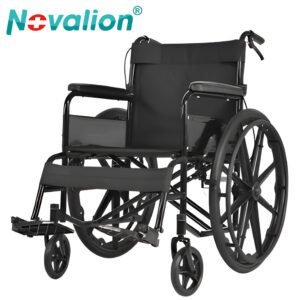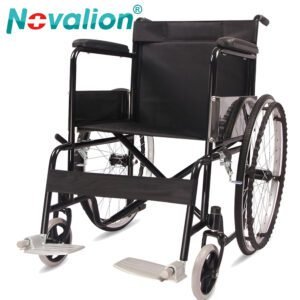Basic Wheelchair: A Complete Guide to Everything You Need to Know
For many individuals with mobility challenges, a basic wheelchair is a vital tool that enhances independence and quality of life. But what exactly is a basic wheelchair, and how does it differ from other types? In this guide, we’ll answer all your key questions about basic wheelchairs, from their design and uses to how to choose the right one and keep it in top shape.
What is a basic wheelchair?
A basic wheelchair is a standard mobility device designed to assist individuals with limited mobility in moving around indoor and outdoor environments with relatively smooth surfaces. It typically features a lightweight frame, four wheels (two large drive wheels with hand rims for self-propulsion and two smaller caster wheels at the front), armrests, footrests, and a simple seating system. Unlike specialized wheelchairs, basic models focus on essential functionality, making them affordable and easy to use for daily activities.
How does a basic wheelchair differ from specialized wheelchairs?
Design focus: Basic wheelchairs prioritize simplicity and affordability, with standard features for everyday use. Specialized wheelchairs (e.g., outdoor, bariatric, or pediatric) have unique designs to address specific needs like rough terrain or larger body types.
Mobility range: Basic models work best on smooth, flat surfaces such as indoor floors, sidewalks, or hospital corridors. Specialized wheelchairs are built to handle challenging environments (e.g., outdoor wheelchairs with large tires for gravel).
Caraterísticas: Basic wheelchairs lack advanced features like tilt functions, pressure-relief cushions, or adjustable seat angles, which are common in specialized models for long-term or medical use.
Custo: Basic wheelchairs are more budget-friendly, while specialized versions with advanced technology tend to be pricier.
Who can benefit from using a basic wheelchair?
Temporary mobility issues: Individuals recovering from surgery, injuries, or illnesses who need short-term assistance getting around.
Mild mobility limitations: People with conditions like arthritis or weakness that make walking long distances difficult but don’t require specialized support.
Indoor or urban use: Those primarily navigating smooth indoor spaces (homes, offices) or city sidewalks and public transit.
Caregiver-assisted mobility: Users who rely on others to push the wheelchair, as basic models often have lightweight frames for easy maneuvering by caregivers.
What features should you look for in a basic wheelchair?
- Material da armação: Steel frames are durable but heavier; aluminum frames are lighter and easier to transport. Choose based on whether portability or sturdiness is a priority.
- Capacidade de peso: Most basic models support 250-300 lbs (113-136 kg). Check the weight limit to ensure it fits the user.
- Dobrável: A foldable design makes storage and transportation (e.g., in cars) easier—ideal for users who travel or have limited space.
- Footrests and armrests: Removable or swing-away footrests simplify transfers, while padded armrests add comfort during use.
- Travões: Reliable wheel locks (brakes) are essential for safety, especially when transferring in or out of the wheelchair.
- Seat size: Standard seat widths range from 16-20 inches (40-50 cm). Choose a width that allows comfortable movement without being too loose.
How to use a basic wheelchair safely?
Pre-use check: Inspect brakes to ensure they lock securely, wheels for proper alignment, and frame for loose parts.
Transfers: Lock the brakes before getting in or out to prevent movement. Use armrests for support, and avoid leaning too far forward or sideways to prevent tipping.
Maneuvering: Push from the rear handles with steady, even pressure. Turn slowly to avoid losing balance, especially on uneven surfaces.
Stairs and curbs: Never attempt to navigate stairs alone—use ramps or ask for assistance. For small curbs, tilt the wheelchair backward slightly (with help) to climb slowly.
Armazenamento: Fold the wheelchair properly (if foldable) and store it in a dry, clean area to prevent damage.
What maintenance does a basic wheelchair require?
Limpeza regular: Wipe down the frame, armrests, and seat with a mild disinfectant to remove dirt and germs, especially if used in public spaces.
Cuidados com as rodas: Check tire pressure (for pneumatic tires) and look for wear. Replace tires if they’re cracked or flat. Lubricate wheel axles periodically to ensure smooth movement.
Manutenção dos travões: Test brakes weekly. If they feel loose or don’t lock properly, tighten the screws or adjust the brake pads. Replace worn brake parts promptly.
Inspeção do quadro: Look for rust (on steel frames) or loose bolts. Clean rust with a wire brush and apply rust-resistant paint. Tighten any loose screws to keep the frame stable.
Cuidados com a almofada: If the seat cushion is removable, wash it according to the manufacturer’s instructions to maintain hygiene and comfort.
Are there different types of basic wheelchairs?
Yes, basic wheelchairs come in a few variations to suit different needs:
- Standard manual wheelchairs: The most common type, with a steel or aluminum frame, push handles for caregivers, and self-propulsion hand rims.
- Transport wheelchairs: Lightweight and foldable, designed for easy transport (e.g., in cars). They often lack hand rims, so they must be pushed by a caregiver.
- Lightweight basic wheelchairs: Made with aluminum frames to reduce weight, making them easier for users to self-propel or for caregivers to maneuver.
What is the typical price range for a basic wheelchair?
Basic wheelchairs are budget-friendly compared to specialized models. Prices usually range from
150to500, depending on factors like frame material (aluminum is pricier than steel), foldability, and brand. Transport wheelchairs may cost slightly less (100−300), while lightweight basic models can be at the higher end of the range due to their materials.
A basic wheelchair is a practical solution for short-term or everyday mobility needs, offering simplicity, affordability, and ease of use. By understanding its features, uses, and maintenance requirements, you can choose the right model to support independence and daily activities.
Obrigado por leres isto, querida, se tiveres alguma sugestão sobre o nosso sítio Web ou se quiser saber mais sobre cadeira de rodas, por favor contactar-nos. Responderemos rapidamente.



